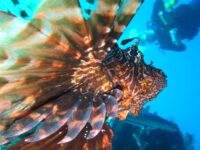
The spotted dolphin is found worldwide in all temperate and tropical oceans. There are 2 species, the Atlantic spotted dolphin and the Pantropical spotted dolphin, with 4 subspecies in the Pacific.
Of those, 2 subspecies exist in the eastern Pacific ocean, a coastal variety with lots of spots and an oceanic form with fewer spots.
It is a small, slender dolphin that grows to about 2 meters and weighs about 100 kg. At birth, they are only about 70 cm long.
Pantropical Spotted Dolphin in Fiji, (Stenella attenuata)

Spotted dolphins in Fiji are quite common. They are often seen in very large pods outside the reefs, but also occasionally enter lagoons.
Spotted dolphins are very active and playful, often appearing next to boats to bow ride or ride the wake. They jump high, doing flips and multiple spins.
Spotted dolphins from large pods of hundreds of individuals, even superpods of several thousand animals.
They hunt in groups and feed on fish and squid. In the Pacific, the spotted dolphin, just like their cousin, the spinner dolphin, often follows tuna schools. They don’t usually feed on Tuna, but prey on the same epipelagic (light zone, 0-200m depth) fish as Tuna hunt. This behavior of swimming with tuna has decimated numbers considerably as they died as bycatch by the thousands in tuna purse-seine fishing nets.
Today, their numbers are recovering, and they are one of the most common dolphins in the world.
 The photos to the right show the use of a dart gun for the collection of a skin sample.
The photos to the right show the use of a dart gun for the collection of a skin sample.
It is an air rifle that is used to shoot a small arrow at a whale or dolphin. The hollow-tipped dart bounces off the dolphin, causing only a minor skin abrasion. The procedure is otherwise harmless to the dolphin.
During this research project in Lomaiviti, Central Fiji, skin samples from whales and dolphins were obtained for DNA analysis.
This was the first scientifically documented presence of Pantropical Spotted Dolphins in Fiji waters. Anecdotally, they are easily confused with the very commonly sighted spinner dolphins.



